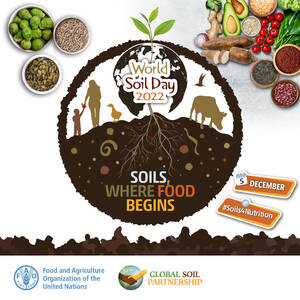
December 5, 2022, by Lexi Earl
The legacy of soil surveys
December 5 is World Soil Day. According to the UN, the purpose is to ‘focus attention on the importance of healthy soil and to advocate for the sustainable management of soil resources’. In this post, Prof Murray Lark reflects on the history of soil surveys and how they can aid our understanding and practices of soil management today.
World Soil Day is an annual reminder that the soil is essential to our wellbeing, whether as a key part of a habitable natural environment, for the production of food and for the regulation of the water cycle. If we are to make sound decisions about the soil then we need to understand it. In particular, we need to understand how its properties vary from place to place. The soil is not the same everywhere, and its capabilities and vulnerabilities vary in space.

Figure 1. Richard Webster (now an emeritus Fellow at Rothamsted Research) conducting soil surveys in Zambia shortly before its independence.
Soil surveys have been undertaken over the last hundred years or so to provide information about the soil and its variations in space. In the 1930s growing interest in understanding soils at continental and global scale led to initiatives to produce soil maps of large tracts of the earth’s surface, and much thought and innovation about how to do this happened in Africa. After African countries became independent of colonial powers they inherited both past soil surveys, and the institutions and capacity to continue the process of mapping soil (Figure 1). Globally, however, the importance of soil surveys has been widely forgotten. Recent efforts to address this problem have focussed on “digital soil mapping” by mathematical prediction from limited numbers of samples with the assistance of remote sensor images and topographic data from satellites and other sources. Although this information is often useful, it does not come with the same depth of understanding of the soil and how it is used which traditional soil surveyors used to acquire in the field.

Figure 2. Some of the InSTAnZa team looking for information at the National Archive of Zambia, Lusaka.
In a recent project, soil scientists from the University of Nottingham and the University of Zambia (UNZA) worked with historians and social scientists in both institutions to examine the legacy of soil surveys which Zambia holds from the colonial period and the years which followed independence in 1964. This project, called InSTAnZa, was led by Professor Murray Lark and funded by the Arts and Humanities Research Council as part of their programme in the Global Challenges Research Fund (Figure 2). As part of this project we set out to list and recover as many soil surveys as possible from Zambia’s Southern and Eastern Provinces (Figure 3). We then evaluated a subset of the recovered maps and presented them to a workshop attended by researchers, extension workers, farmers and representatives of private companies and NGOs.

Figure 3. Zambia and its provinces.
Our principal discovery was that, although we could demonstrate the existence of nearly sixty different soil surveys conducted in these provinces, neither the map nor accompanying memoir describing the soils could be recovered in 64% of cases after a careful search of archives in Lusaka. In a further 14% of cases the memoir could be found but not the map sheet. This is a sad loss of a valuable source of critical information. We argue that it is necessary both to look further to recover as much as possible, and to take steps to ensure that what remains of this legacy is found, digitized and made available online. Of course, this applies to the other provinces of Zambia, and in other countries globally with a legacy which has not as yet been safeguarded.
But mere preservation is not enough. At our workshop there was considerable interest in the legacy soil information which Zambia holds, and in its possible value. Our participants could see how legacy soil surveys might be treated as baseline information to see how the soil has changed over time, and as a direct source of information on some soil properties as input to models or related support for decisions that have to be made now to sustain food production under climate change. Legacy information can be combined with new observations to produce updated soil maps, and can contribute to the assessment of land suitability. Legacy soil information might also be used to address new problems, such as pollution, not envisaged when some of the earlier surveys were undertaken. Finally, it was recognized that soil surveys embody a lot of integrated knowledge about soil, vegetation and farming systems, and that some of this could contribute to the development of new systems for Zambia to use in the future.
For more information an open access paper on this study can be found here https://doi.org/10.1016/j.geoderma.2022.115874
This work was conducted under the project entitled Towards Transdisciplinary Understanding of Inherited Soil Surveys: an exploratory case study in Zambia (InSTAnZa). The project was supported by the Arts and Humanities Research Council [Grant No. AH/T00410X/1] through their Programme Cultures, Behaviours and Histories of Agriculture, Food, and Nutrition, part of UK Research and Innovation’s Global Challenges Research Fund.

No comments yet, fill out a comment to be the first

Leave a Reply